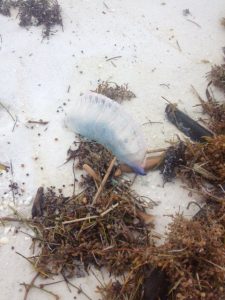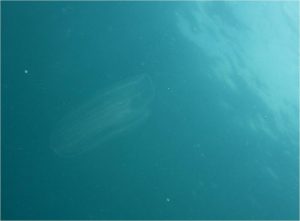
Photo: Rick O’Connor
Many in the tourism industry hear this frequently – and it’s understandable. You work all year at your job in Missouri, plan a fun week long vacation on the Gulf coast, make the reservations, and arrive only to find you can’t go swimming because the jellyfish are here.
So when should I book my vacation?
Well… it’s hard to say. Jellyfish do swim but they are very weak swimmers and so “go with the flow” – they travel where the wind and currents take them. There are seasonal patterns to currents, and this helps a little with predicting when they will arrive, but I am sure everyone has noticed a change in seasonal weather in recent years. Historically, the surface drifting hydrozoans – such as the Portuguese Man-of-War and the By-the-Wind Sailors come in early – actually, we have already had an invasion of them this past February. The classic scyphozoans – such as sea nettles and moon jellies – are later in the summer, though I have seen remains of moon jellies already. So unfortunately, it is hard to tell you which week you should make your vacation. It is similar to asking, “which week will the hurricane come”? There are tendencies, but no guarantees.

Photo: Sea Grant Collier County
I can tell you a little about “your enemy”, the jellyfish – so that you will better understand them. Jellyfish come in basically two forms – those that can sting (Cnidarians – pronounced “kni-dairy-ins”) and those that do not (Ctenophorans – pronounced “t-noph-o-rans”). Ctenophorans are commonly called comb jellies and are oval shaped jellies that lack tentacles. There are actually comb jellies that do have tentacles, but the local species do not. They are called comb jellies because they have eight rows of “ctenes” – which are hair-like structures used in swimming. The ctenes move in a similar fashion to the spikes on a comb when you run your thumb down them – one after another move in a pattern. This propels the animal through the water, but again – not against a current or tide. They do not possess nematocyst (the cells that sting) so they are harmless. They actually produce a luminescent glow at night and are quite beautiful. These are not the jellies that call out the purple flag by lifeguards – those would be the cnidarians.
Cnidarians do possess nematocyst. Nematocyst are coiled darts encased in a gelatinous cell called a cnidoblast and each dart possess a drop of venom. The pain associated with a jellyfish is a function of the type of venom they possess. Locally, the drifting Portuguese Man-of-War probably has the most toxic venom, thus the most painful sting. The sting of this jellyfish is quite painful and has sent people to the hospital – it is one that should be avoided.
How would I know a Portuguese Man-of-War?
Identification is pretty simple… they have a dark/bluish-purplish color to them. They produce a gelatinous “sail” that extends above the surface of the water and captures ocean breezes to move around – which is how they end up here at times. Below the sail is a bluish bag – almost looks like a balloon – and hanging from this are numerous long tentacles, some can reach several feet in length. What many do not know is that the PMOW is not actually one animal – but a colony of numerous smaller ones. They are all attached to each other along the tentacles. As a team, they produce the “balloon” and the “sail” for locomotion and then extend their small personal tentacles into the water to capture prey – usually fish. When a fish is killed, the individual will pull the prey into their mouth (no teeth). The stomachs of each member are connected and so as one feeds – they all feed. To feed such a colony you need a relatively large fish, and to kill a relatively large fish you need a strong venom – and they have a strong venom. They do have a close cousin, the By-the-Wind Sailor. It too is bluish/purple but lacks the balloon structure and the long tentacles. It looks more like a flat blue disk with a small sail. Their venom is not as strong. I have never held one so I do not know how bad the sting is, but I rarely hear of people complaining about them. Actually, I hear more people calling them PMOW’s – which is incorrect.
Sea nettles are a common stinging jellyfish we see from mid to late summer. Nettles are not a colony but one individual jelly. They have the classic round bell and extended tentacles that produce a venom that is painful, but not as painful as the PMOW. They are typically in large groups and can make swimming unpleasant. Actually, the surf can rip the extended tentacles into fragments. The nematocysts within the tentacles can still sting, even if not attached

Photo: Janet Krenn Virginia Sea Grant
to the jellyfish. This is true for dead jellyfish on the beach as well. The nematocyst are actually triggered by contact with an object, not consciously by the jellyfish themselves. Often, swimmers come from the water feeling as if they have been stung but see no jellyfish – this explains this.
It is hard to predict when the different jellyfish will be inshore during the vacation season, but that should not stop you from planning a great vacation. Usually when the jellyfish are numerous on the Gulf side, they are not in the Sound – and vis versa – following the tides. So, there are some location where you can enjoy your favorite water sport no matter what.
 0
0
